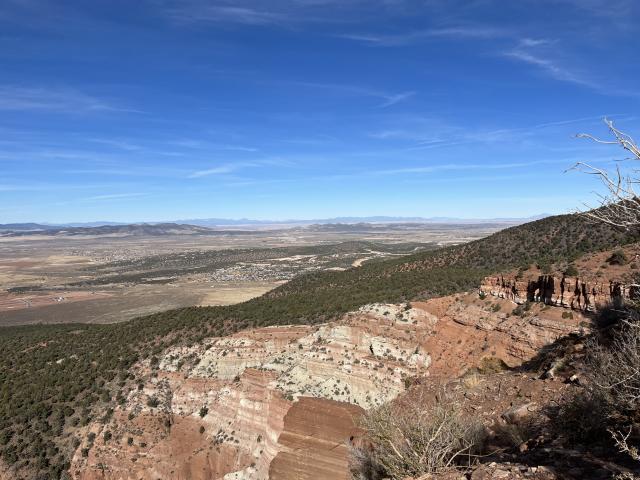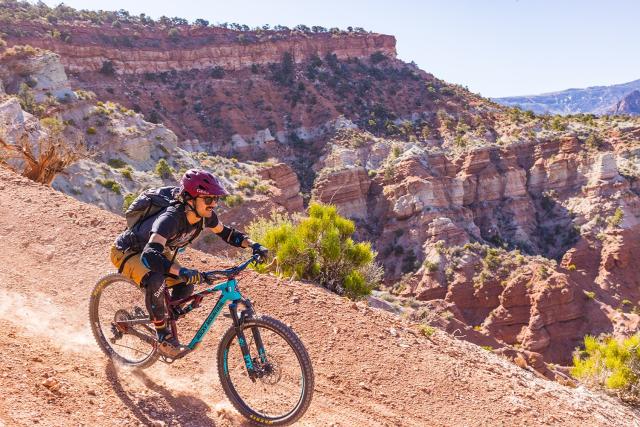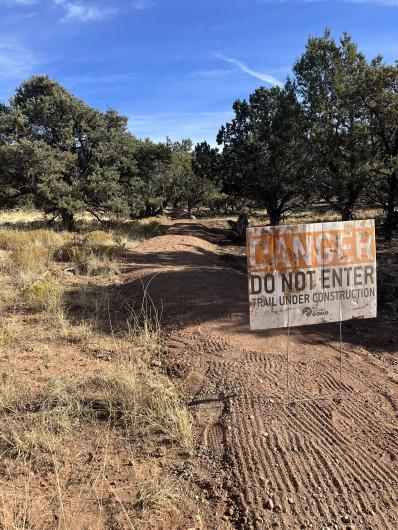New Iron Hills Trail System segment in Utah receives a critical investment of funds and partners
Listen
Subscribe
Related Content
BLM-Utah's Color Country District received funding from the Inflation Reduction Act to expand its network of recreation trails at Iron Hills near Cedar City, Utah. In this episode, Mike Innes, an Outdoor Recreation Planner in the BLM's Cedar City Field Office, talks about the essential help from partners and volunteers to create a well-constructed mountain biking trail. The Iron Hills National Recreation Trail receives more than 35,000 visitors annually.
Transcript
NARRATOR, DAVID HOWELL (Host): Cedar City, Utah is the launch point for many trips to places like Zion National Park, Bryce Canyon National Park, and Cedar Breaks National Monument. Right on the outskirts of town are some outstanding hiking and mountain biking trails managed by the Bureau of Land Management.
I’m David Howell, and you’re listening to “On The Ground, A Bureau of Land Management Podcast.” On the southeast foothills near Cedar City is the Iron Hills National Recreation Trail. It’s not your traditional point-to-point trail, but more of a network of nearly 20 trails covering about 32 miles, and all bunched up into those foothills. Iron Hills was mostly designed for mountain biking and boasts a variety of trails from beginner to expert. The latest addition to this network is a trail called “The Breaks,” which officially opens in 2025. Mike Innes is an outdoor recreation planner in BLM’s Cedar City Field Office, and he says that the journey to create this new trail has been several years coming.
MIKE INNES (Outdoor Recreation Planner): So this new trail will be adding almost four miles to the trail system, so this, for one trail, it's a pretty big build! We're really excited. This was originally designed and flagged out in 2020, so there's been a lot of public anticipation for this. After it was designed, we were trying to build it every year after that, but with it being that long -- and it's through some pretty rough terrain, which usually equals out to a pretty expensive project -- so we just haven't been able to get the funding together for it. So that's why we were so excited to learn that this was going to be funded through the Restoration Landscapes and IRA.
HOWELL: Oh, okay – so this is funded by the Inflation Reduction Act. I actually thought it was, maybe, funded by the Bipartisan Infrastructure Law.
INNES: Yeah, this is IRA. But it's pretty cool because the whole general project area is is kind of a great example of the positive things that can come from these types of funding sources, and when management and political leaders decide to invest in recreation. Because, we have The Breaks trail that's going in -- that's an IRA funded project -- and where that trail leaves and returns from started as a trailhead, and was recently converted and constructed a campground there. That campground 's been insanely popular, and so it's kind of hit the time where we need to expand it. And so the expansion of the campground and trailhead will also be starting this fall. And THAT project has received BIL funding. So it's kind of both of these two funding sources, working together in the same area, to really bring about a great product that's going to get thousands and tens of thousands of people using per year.
HOWELL: So how do “constructed” mountain biking trails help to manage the potential for damage on the landscape, versus, you know, someone taking a bicycle up into the hills without any real forethought about where they’re actually biking?
INNES: When it comes to professionally constructed trails, every time we have a crew in, I try to get out and spend as much time with them as possible because it's so cool to hear how they talk about what they're doing, because they have it down to a science. And it really is a natural science. And so, everything they're doing with design and construction is totally related to hydrology and water and how to move water off the trail, down to soil types and what soil types will hold up better in locations that trails will work better than others, and things like that. So yeah, there's a insane amount of kind of science…
HOWELL: It's really intentional then.
INNES: …and that, when it goes into it. Yeah, absolutely.
HOWELL: Four miles of trail: What do you think is going to be the experience of people…. what are they going to encounter as they go down this new trail you're building?
INNES: All of the trails in the Iron Hills Trail system have been purpose-built mountain bike trails. A lot of them, almost all of them, are multi-use, so hikers and trail runners are on them as well, but they've been built with the focus of the mountain bike experience. And this trail is going to be very similar. But there has been a lot of thought for “the hiker” when it comes to this one, especially because where this trail will end, at the high point, is known as that “Breaks” feature: it's the iconic red rock feature you see as you're traveling north on I-15 coming into town.
HOWELL: Right.
INNES: And the trail will go to the top of that, which I think is one of the most amazing lookouts you can have in the Cedar City area. And so, because of that, with the hiker user group typically just focusing on getting to a destination, we anticipated this being a popular trail for that group as well.
So there was a lot of thought and consideration that went into the hiker when it came to the layout and design, and it's currently happening with the construction as well. There are trails that access that lookout point right now, but they're very advanced “black diamond” trails and extremely physical to get up there. This trail is going to be a “Blue” rated trail.
HOWELL: OK, so a little bit more moderate, then.
INNES: Yeah, it'll be much more moderate than the other way up. And with the mountain bike user group, I would say that intermediate level rider probably makes up the majority of the user group. And so this trail will allow so many more people to be able to access that lookout and that experience, and have a nice enjoyable ride both up and down because this will be a a bidirectional trail.
HOWELL: Yeah, I was gonna ask you, cause a lot of the ones that I have seen -- especially new mountain biking trails -- tend to be flow trails; you start from one end and you kind of go off down to another place. But this one will actually be one where you have traffic going in both directions.
INNES: It will be. And like I said, there's been a lot of consideration in that. So, the folks from the International Mountain Bike Association (IMBA) Trail Solutions, who designed and is constructing right now, they were thinking about that kind of every step of the way -- and speeds and sight lines and making sure we weren't putting people in bad or dangerous situations when it comes to “mountain bike-hiker” and “biker-biker” interaction.
HOWELL: Tell me a little bit about how mountain biking trails have been received right around the Cedar City area? Because for one, I can imagine they'd be pretty popular being a college town; you know, you'd attract a whole bunch of young people to it. But probably not exclusively young people, as well.
INNES: The growth of mountain biking in the Cedar City area has… It's kind of exploded in not too much of time. Trail construction started here in 2015, and before that the Three Peaks area -- I don't know if you're familiar with that -- but that was the only bike trails that really existed, and they were all user-created. There was an obvious need for this type of recreation.
When trails started being constructed, the local community immediately bought in. And right from the beginning, Iron Trailcraft began, which is our local nonprofit trail club. They started, and they've been a part of this entire process every year since. They they're involved in, really every part of the build, or even before the build from design. Each time a trail construction project starts, that local volunteer group is working with whatever professional trail crew is out there. And then, that club, on average, is putting in over six hundred hours of volunteer time to the trails per year now, so they're extremely invested.
The sense of ownership and the involvement of these volunteers is something you don't see in a lot of places. So that's been awesome to see and be part of. And then also, just from our local Utah High School Cycling League (chapter) -- they started, I think, in 2017 or 2018, was the first year that that team started, and they had 20 kids. And I think this year they have more than 120 kids.
HOWELL: Oh, my goodness!
INNES: So that team has grown each year, too, so it's been kind of this fluid thing: like, as the trail system grows, the team and the ridership does as well.
HOWELL: So looking forward, when do you anticipate the trail’s going to be open?
INNES: We’re still waiting to kind of see what the weather does. Best case scenario, when you finish a trail, before you open the trail, you want a winter to sit on it. It really helps the soils to absorb that moisture and compact, and so we're still waiting to see how much rain we get. And so we might be just keeping it closed and waiting for a spring opening.
HOWELL: Wait until next spring. That probably makes some sense. Well, best of luck to you! Sounds like it's going to be a great experience.
INNES: Thank you, David!
NARRATOR: Mike Innes is an outdoor recreation planner in BLM’s Cedar City Field Office. We’ll have a link to the Iron Hills Trail System on our website for this episode, plus much more, and if you’re looking for other trails on public lands, I encourage you to check out our website at BLM.gov/recreation.
There is a lot to do out on public lands, so go enjoy them! I’m David Howell, and we’ll see you out there, “On The Ground.”






